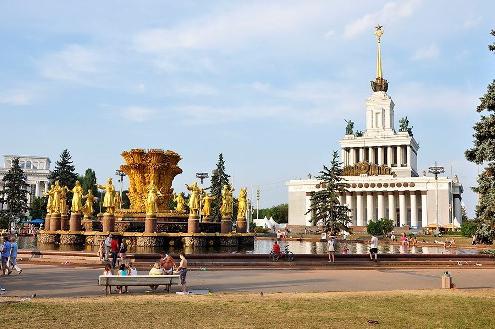Today, this vast territory in the northern part of the capital is officially called the All-Russian Exhibition Center. But in Soviet history it is better known as VDNH - "The All-Union Exhibition of Achievements of the National Economy." Exhibition pavilions of VDNH very vividly reflect the era in which they were erected. It was a showcase of the entire Soviet Union, that image in which a great power wanted to present itself to the whole world. Both external and internal.
Pavilions of VDNH - a legacy of the historical era
Perhaps there is no second place in all of enormous Moscow where the architectural heritage of the Stalin era would be represented with such fullness, in such concentration and in such diversity. It is just an open-air architectural museum. Anyone who wants to understand the content and feel the color of forever past times should come to VDNH. The map of the pavilions remained the same, as the once-famous Moscow architect Vyacheslav Konstantinovich Oltarzhevsky arranged them, the project of which was accepted for execution after the competition. He was unable to complete what he started. The grandiose construction on 136 hectares could not be completed in a timely manner, the architect was repressed and exiled to Vorkuta. The VDNH pavilions are randomly located only at first glance, but their layout is designed so that the thematic content of each object gradually unfolds before the visitor.

The All-Union Agricultural Exhibition was a unique complex of structures, which was not equal not only in Moscow, but throughout the world there were not so many. The pavilions of VDNH were to demonstrate the content not only according to the industry principle, but also reflect the national flavor of the republics of the Soviet Union, each of which was presented at the exhibition. In total, at the time of opening there were 250 different thematic structures, as well as alleys, reservoirs and fountains. The opening of the exhibition took place on August 1, 1939, which was an event of great national importance. Molotov
delivered a welcoming speech to the audience. The exhibition was planned as a permanent one, but after the
start of World War II it was closed. VDNH pavilions again received visitors only seven years later, when everything was restored to its original form. In the post-war period, reconstruction and further development work took place on the territory, new pavilions appeared. They reflected a new time. To this day, one of the most important and most visited is the pavilion "Cosmos". In the nineties, a significant part of the architectural heritage was irretrievably lost.
VDNH Pavilions: opening hours
Currently, the All-Russian Exhibition Center is open to receive visitors daily on weekdays from 9 am to 9 pm. On weekends and holidays until 10 pm. Pavilions on its territory open at 10 a.m. and work until 6 p.m. on weekdays, until 7 p.m. on weekends and on holidays. In summer, the territory is open until 11 pm, and all pavilions are open an hour longer.